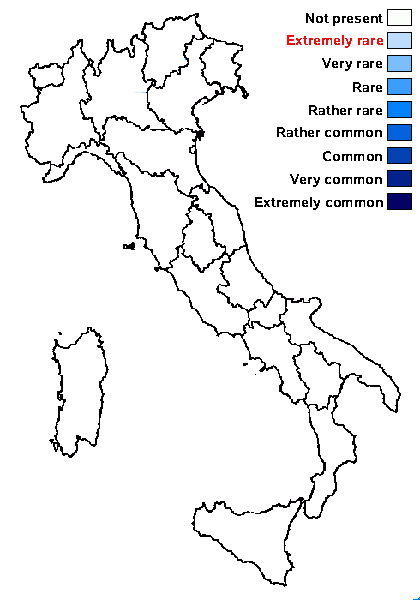Thelopsis lojkana (Poetsch ex Arnold) Nyl.
Flora (Regensburg), 64: 457, 1881.. Basionym: Sagedia lojkana Poetsch ex Arnold - Verh. zool.-bot. Ges. Wien, 25: 447, 1875.
Synonyms:
Distribution:
Description: Thallus crustose, endosubstratic or very thinly episubstratic, grey-white, sometimes with a bluish tinge due to colonies of cyanobacteria. Perithecia scattered, half-immersed, 0.6-0.8 mm across, black, smooth, somewhat flattened or slightly depressed in the apical part. Exciple c. 100 μm wide in upper part, c. 50 μm in lower part, pale in inner part, brownish in outer part; hymenium colourless, I+ blue-green turning reddish; periphyses c. 1 μm thick, up to 60 μm long; paraphyses 300-350 x c. 1.5 μm. Asci 50-100-spored, cylindrical, tapering towards the apex, the wall thin, 1+ light blue, without a tholus. Ascospores (1-)3(-4)-septate, hyaline, spindle-shaped, 18-25 x 3.5-5 μm, thin-walled, surrounded by a thin gelatinous perispore. Photobiont trentepohlioid. Spot tests: thallus K-, C-, KC-, P-, UV-. Chemistry: without lichen substances. Note: on vertical to underhanging faces of limestone in the shade of montane forests; rare in the Central European mountains, with a few scattered records from the Alps; to be looked for in Italy.
Growth form: Crustose
Substrata: rocks
Photobiont: Trentepohlia
Reproductive strategy: mainly sexual
In underhangs rarely wetted by rain

Predictive model
Growth form: Crustose
Substrata: rocks
Photobiont: Trentepohlia
Reproductive strategy: mainly sexual
In underhangs rarely wetted by rain

Predictive model

